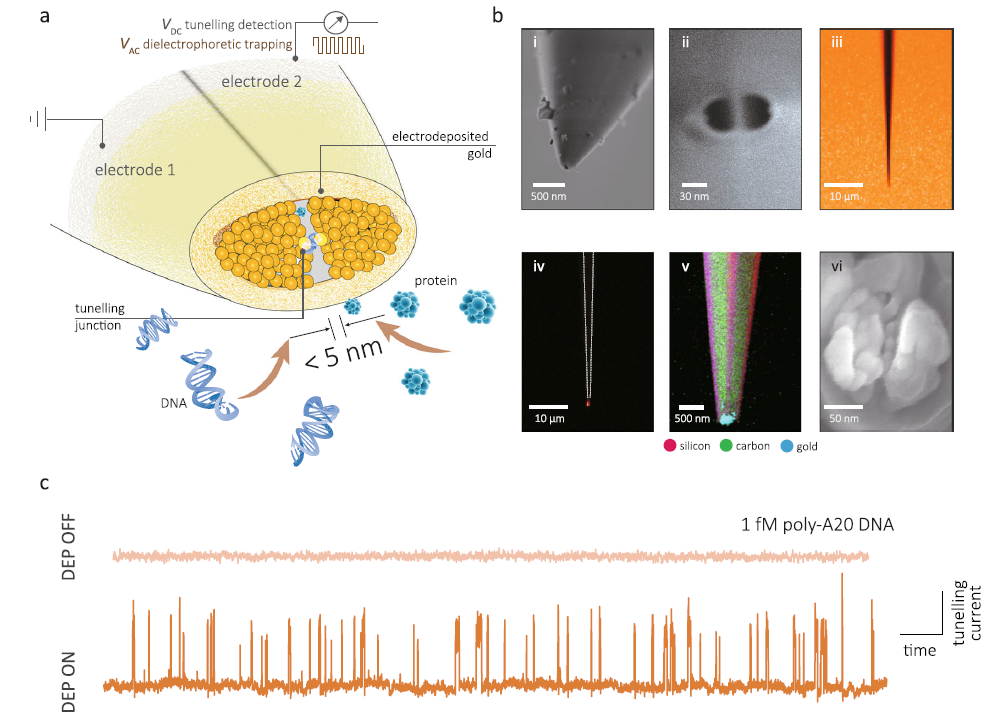On May 18th, “Measuring Conductivity switching in single proteins using quantum tunneling” was published online by 《Science Advance》 in a collaboration between Longhua Tang from College of Optical Science and Engineering, Zhejiang University and Aleksandar P. Ivanov and Joshua B. Edel from Imperial College London.
In this study, quantum mechanical Tunnelling probes were used to measure the long time conductance of single protein molecules, and the dynamic conductance response of single protein molecules under bias pressure was observed in room temperature and solution environment. 《Science Advances》 website uses the word "I" to highlights report. The device technology is expected to be used to explore the real-time conformation and functional mechanism of proteins in biological processes, and has important application value in protein dynamic functional characterization, bio-optoelectronic devices and other fields.
Research Background
Protein is a necessary component in living organisms and the main undertaker of life activities. The electron transport of proteins is closely related to the important life processes such as energy rotation and energy conversion. For example, proteins are an important part of the electron transport chain as natural electron transport agents in respiration, photosynthesis and other key biological processes. Therefore, it is of great significance to study the electrical transport of proteins, not only to understand the conformation and functional mechanism of proteins, but also to develop novel protein regulation and characterization techniques. However, there are still technical challenges to realize real-time conductivity measurement of single molecule proteins at room temperature and in solution environment.
Scientists have been looking for reliable ways to combine proteins with bio-optoelectronic devices to better understand and manipulate protein-mediated electron transport. In 2019, Stuart Lindsay and his team at Arizona State University used electrochemical scanning tunneling microscopy (EC-STM) for the first time to observe the supernormal charge transfer ability of nonmetallic proteins under certain conditions in the laboratory. However, the working principle of EC-STM makes it difficult to construct a long-term stable metal-biomolecular-metal junction, which cannot meet the long-term stability measurement of protein, hinds further understanding of the nature of protein electron transport, and limits the functional application of this type of protein molecular device.
Longhua Tang's research group focuses on the research of molecular optoelectronic devices, high spatial and temporal resolution measurement technology and instruments. In collaboration with Aleksandar P. Ivanov and Joshua B. Edel of Imperial College London, they have made important advances in the field of quantum tunneling junction devices and single-molecule measurements. A novel quantum mechanical Tunnelling (QMT) device was developed to realize the controllable fabrication of sub-nanometer to 5 nanometer tunneling junction devices. The device consists of a pair of stable and gap size controllable tunneling electrodes, integrated into the tip of a hundred-nanometer diameter, suitable for long-term optical or electrical measurements in solution. In addition, the tune-through junction device is compatible with dielectric electrophoresis technology, which enables single-molecule electrical measurement at ultra-low concentrations (< 10-15 mol/L). The results were published in 《Nature Communications》 in 2021 (FIG. 1).

In order to solve the key problem of protein dynamic conductivity measurement, they proposed a novel tunneling junction device embedded with single molecule protein, which can achieve microsecond time-resolved conductivity measurement in solution, and for the first time measured the dynamic response of protein conductivity under bias dependence. The tunneling electrode surface is first modified with thiol biotin and then combined with streptavidin, a non-redox active tetramer, to measure the quantum tunneling electrical signal of a single non-redox active protein in a solution environment (Figure 2). The results of I-T and I-V scanning under different bias voltage showed that the protein conductance was positively correlated with the bias voltage. At the same time, all the current signals showed consistent oscillatory characteristics when measured for a long time under different bias voltages, demonstrating the stability of the protein connection and the reproducibility of its electrical properties.
In order to solve the key problem of protein dynamic conductivity measurement, we proposed a novel tunneling junction device embedded with single molecule protein, which can achieve microsecond time-resolved conductivity measurement in solution, and for the first time measured the dynamic response of protein conductivity under bias dependence. The tunneling electrode surface is first modified with thiol biotin and then combined with streptavidin, a non-redox active tetramer, to measure the quantum tunneling electrical signal of a single non-redox active protein in a solution environment (Figure 2). The results of I-T and I-V scanning under different bias voltage showed that the protein conductance was positively correlated with the bias voltage. At the same time, all the current signals showed consistent oscillatory characteristics when measured for a long time under different bias voltages, demonstrating the stability of the protein connection and the reproducibility of its electrical properties.
Summary
In this study, the molecular junction of a single protein was constructed with a sub-5nm distance tunneling junction device, and the protein conductance was measured for a long time (>2 hours) at room temperature and in solution environment. The dynamic response conductance of the protein under bias was measured for the first time, and the influence mechanism of electric field on the electron transport behavior of the protein was further analyzed. This study provides a new method for the construction of single-molecule protein devices, provides a new technology for measuring the molecular conductance of individual proteins, and is expected to provide an important tool for real-time conformation and functional analysis of proteins, which has important applications in protein sequencing, bio-optoelectronic devices and biochemical sensing.
Publishing information
The first author of this paper is Longhua Tang from College of Optical Science and Engineering, Zhejiang University , and the corresponding authors are Aleksandar P. Ivanov and Joshua B. Edel from Imperial College London. This project has also received the guidance and strong support of Professor Liu Xu from Zhejiang University, Professor Stuart Lindsay from Arizona State University and Professor Guo Xuefeng from Peking University. The research was carried out with the support of the National Major Scientific Instruments and Equipments Development Project of National Natural Science Foundation of China "Single molecule time-space resolved Photoelectric nanomirror" and the Zhejiang Provincial Dintinguished Youth Scholars.
Full paper address:
https://www.science.org/doi/10.1126/sciadv.abm8149






